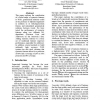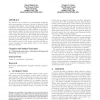221 search results - page 19 / 45 » Word Sense Disambiguation Using Pairwise Alignment |
TAL
2010
Springer
13 years 6 months ago
2010
Springer
Mihalcea [1] discusses self-training and co-training in the context of word sense disambiguation and shows that parameter optimization on individual words was important to obtain g...
AAAI
2011
12 years 8 months ago
2011
Effective access to knowledge within large declarative memory stores is one challenge in the development and understanding of long-living, generally intelligent agents. We focus o...
PAMI
2010
13 years 6 months ago
2010
— Word sense disambiguation (WSD), the task of identifying the intended meanings (senses) of words in context, has been a long-standing research objective for natural language pr...
COLING
2002
13 years 8 months ago
2002
This paper explores the contribution of a broad range of syntactic features to WSD: grammatical relations coded as the presence of adjuncts/arguments in isolation or as subcategor...
JCDL
2011
ACM
12 years 11 months ago
2011
ACM
We describe here a method for automatically identifying word sense variation in a dated collection of historical books in a large digital library. By leveraging a small set of kno...


